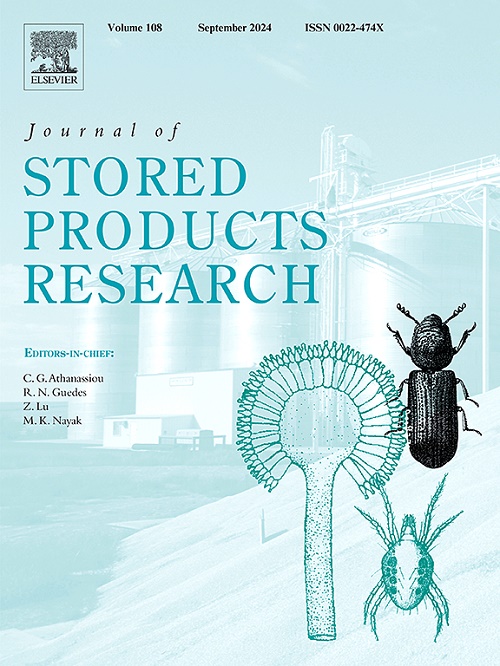Sorption, desorption, and residue analysis of the fumigant ethyl formate in date fruits using cooled methanol extraction and GC-MS
IF 2.7
2区 农林科学
Q1 ENTOMOLOGY
引用次数: 0
Abstract
Ethyl formate (EF) exhibited promising activity against pests of stored date fruits, showing its potential as an alternative fumigant to replace phosphine and methyl bromide (MB). However, the information related to sorption, desorption and residues in date fruits is lacking. Therefore, the present study explored the sorption and desorption of EF at application doses of 70 and 140 mg/L in dry dates (Ghazali) and semi-dry dates (Elwadi-I). Moreover, the study developed and validated a method to determine the actual residues of EF in both date varieties using cooled methanol for extraction and analyzed by gas chromatography-mass spectrometry in selected ion monitoring. The actual amounts of EF residues in both date varieties fumigated at 70 and 140 mg/L for 24 h were quantified. The initial doses applied decreased by 71.5 and 52.9% at 70 mg/L and by 72.5 and 48.0% at 140 mg/L for Ghazali and Elwadi-I, respectively, after 24 h of fumigation. There was a notable desorption of EF from both date varieties, with about 20.0% released from the initial doses applied after 24 h of resealing. Sorption rates of EF in Ghazali and Elwadi-I were 237.71 and 185.17 mg/kg at 70 mg/L and 482.6 and 336.75 mg/kg at 140 mg/L, respectively. The developed method achieved a high level of precision and selectivity, with an acceptable recovery between 80.22 and 92.35% and a relative standard deviation <20.0%. The limit of detection (LOD) and limit of quantitation (LOQ) were 0.01 and 0.1 mg/kg, respectively. The initial amounts of EF residues in Ghazali and Elwadi-I date fruits after 0 h (15 min) of aeration were 48.24 and 30.08 mg/kg following the fumigation at 70 mg/L and were 95.95 and 81.74 mg/kg when fumigated at 140 mg/L, respectively. However, EF residues were undetectable after 72 h of aeration. These findings are important for the implementation of EF as a stored date protectant agent.
求助全文
约1分钟内获得全文
求助全文
来源期刊
CiteScore
5.70
自引率
18.50%
发文量
112
审稿时长
45 days
期刊介绍:
The Journal of Stored Products Research provides an international medium for the publication of both reviews and original results from laboratory and field studies on the preservation and safety of stored products, notably food stocks, covering storage-related problems from the producer through the supply chain to the consumer. Stored products are characterised by having relatively low moisture content and include raw and semi-processed foods, animal feedstuffs, and a range of other durable items, including materials such as clothing or museum artefacts.

 求助内容:
求助内容: 应助结果提醒方式:
应助结果提醒方式:


